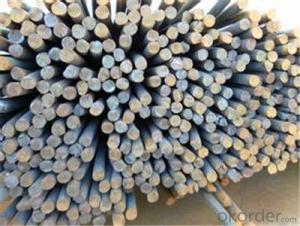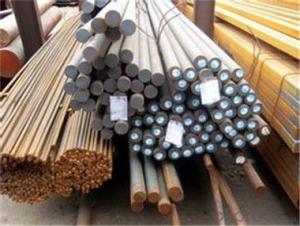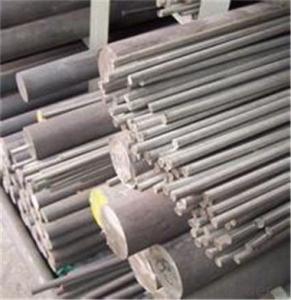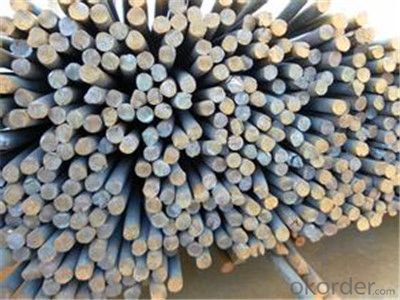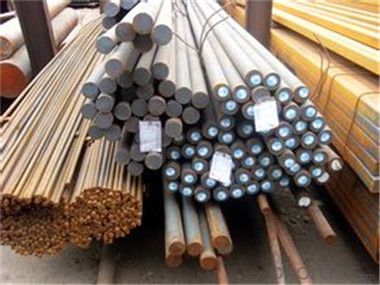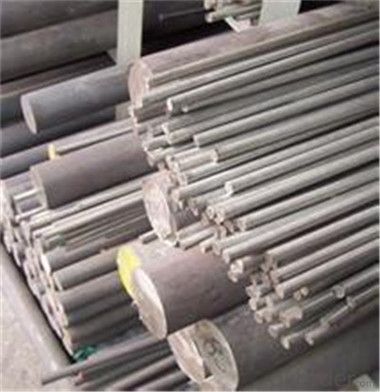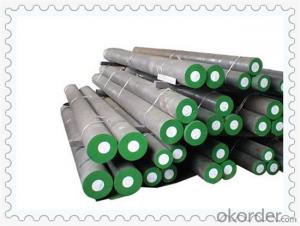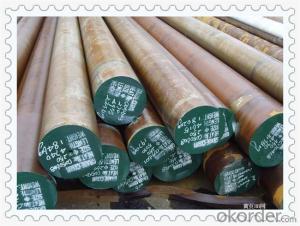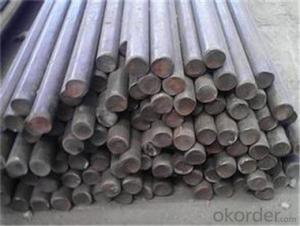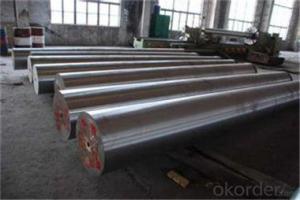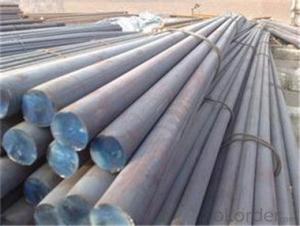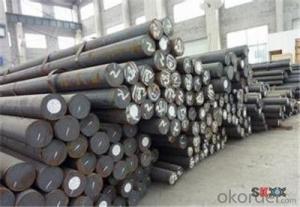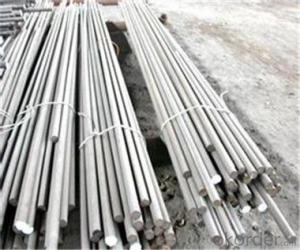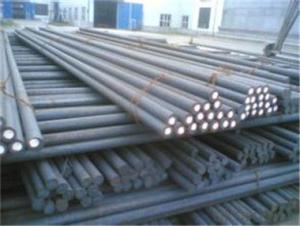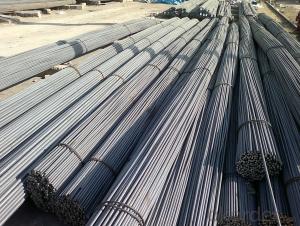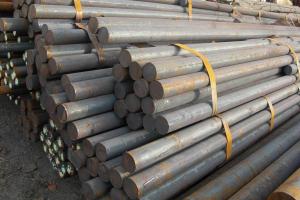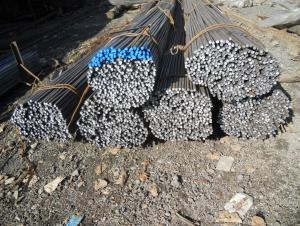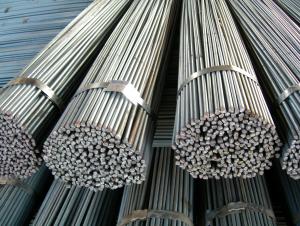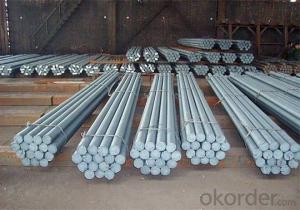Steel Round Bar Reliable Manufacturer with Good Quality
- Loading Port:
- Tianjin
- Payment Terms:
- TT OR LC
- Min Order Qty:
- 20 m.t.
- Supply Capability:
- 2000000 m.t./month
OKorder Service Pledge
OKorder Financial Service
You Might Also Like
Specification
Description of steel round bar:
1.Diameter 80 to 800 mm
2.Black or Bright surface
3.Annealed or Quenched and tempered provided
4.Cutting service provide
Festures of steel round bar:
4340 Forged Round Steel Bar
1.Dia 80-800mm Length:2000-13000mm or as required
2.Technique:Forged
Cold work tools
Cutting and pressing tools
Cavity moulds
Measuring tools
Stamping tools
Deep drawing tools and presses
Industrial shears
Specifications of steel round bar:
1. Standards: AISI 4340 8620 8640 4320 , JIS SNCM8 GB:40CrNiMoA
2. Specification: Dia: 80~450mm Length:2000-13000mm or as required
3. Process: EAF+LF+VD ( necessary) UT+ Peeled +Turned + Heat Treatment (optional)
4. Chemical Composition (%):
C | Si | Mn | S | P | Cr | Ni | Cu | Mo |
0.37-0.44 | 0.17-0.37 | 0.40-0.80 | 0.025(max) | 0.025(max) | 0.60-0.90 | 1.25-1.65 | 0.025(max) | 0.15-0.25 |
Images of steel round bar:
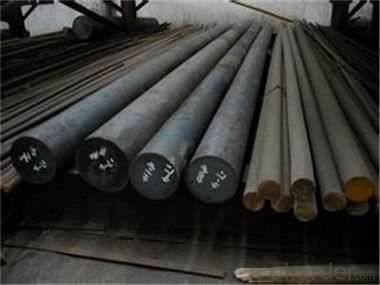
FAQ:
1. What is your package?
Packing situation: standard seaworthy packing or as customer required.
2. How long is the lead time?
Delivery time: 45 days after order confirmed.
3. What payment term do you accept?
Payment: T/T or L/C at sight.
- Q: Are steel round bars available in different colors?
- No, steel round bars are typically available in a silver or gray color as they are made from alloyed iron and carbon.
- Q: What are the properties of steel round bars?
- Steel round bars have several properties that make them a popular choice in various industries. Firstly, steel round bars are known for their strength and durability. Steel is one of the strongest materials available, and this strength is retained in the round bar form. This makes steel round bars ideal for applications where high strength and toughness are required, such as in construction, manufacturing, and engineering. Secondly, steel round bars have excellent machinability. They can be easily cut, drilled, and shaped, making them versatile for use in different projects. This property allows for easy fabrication and customization of the round bars to meet specific requirements. Furthermore, steel round bars have good corrosion resistance. They are often made from stainless steel or alloyed steel, which increases their resistance to rust and other forms of corrosion. This makes them suitable for use in outdoor and harsh environments, where exposure to moisture and chemicals can cause damage to other materials. Another important property of steel round bars is their high thermal and electrical conductivity. This makes them suitable for applications where heat or electricity needs to be conducted efficiently, such as in electrical systems or heat exchangers. Additionally, steel round bars have a smooth and polished surface finish. This not only enhances their aesthetics but also improves their resistance to wear and tear. The smooth surface reduces friction and allows for easy movement or rotation, making steel round bars suitable for use in mechanical components and machinery. Lastly, steel round bars are available in a wide range of sizes, grades, and finishes. This allows for flexibility in application and ensures that the right round bar can be selected based on specific requirements. Overall, the properties of steel round bars, including their strength, machinability, corrosion resistance, thermal and electrical conductivity, surface finish, and availability in various sizes and grades, make them a versatile and reliable choice for many industrial applications.
- Q: What are the advantages of using sulfur-alloy steel round bars?
- Sulfur-alloy steel round bars offer several benefits. Firstly, they have superior machinability compared to other steel types. Adding sulfur to the alloy reduces friction between the tool and workpiece, resulting in smoother cutting and lower cutting forces. This simplifies and improves the efficiency of machining, saving time and reducing costs. Secondly, sulfur-alloy steel round bars possess excellent chip-breaking properties. The sulfur content encourages the formation of small, brittle sulfide inclusions within the steel, which act as effective chip breakers during machining. These inclusions break the chips into smaller pieces, preventing tangling and issues like built-up edges or poor surface finish. Another advantage is the improved surface finish of sulfur-alloy steel round bars. The sulfur content in the alloy minimizes the occurrence of built-up edges or burrs during machining. As a result, a smoother and more precise surface finish is achieved, which is particularly crucial for applications that require aesthetics or tight tolerances. Moreover, sulfur-alloy steel round bars exhibit good wear resistance. The sulfur content forms hard sulfide inclusions that enhance the hardness and wear resistance of the steel. This makes it suitable for applications subjected to abrasive wear, such as gear or bearing manufacturing. Lastly, sulfur-alloy steel round bars are frequently more cost-effective compared to other high-performance alloys. Adding sulfur is a relatively inexpensive process, making sulfur-alloy steel a more affordable option for many applications. This makes it an appealing choice for industries that require high-quality steel while considering costs. In conclusion, the benefits of using sulfur-alloy steel round bars include improved machinability, enhanced chip-breaking properties, better surface finish, good wear resistance, and cost-effectiveness. These advantages make sulfur-alloy steel round bars a popular choice in various industries, including automotive, aerospace, and manufacturing.
- Q: What are the different shapes available in steel round bars?
- There is a wide range of shapes available for steel round bars, each tailored to meet specific needs and applications. Some commonly used shapes include: 1. Round: This is the most basic and commonly used shape for steel round bars. It has a circular cross-section and finds applications in industries like construction, manufacturing, and engineering. 2. Square: Square steel round bars have a square cross-section, making them ideal for applications that require stability and structural strength. They are often used in constructing frames, supports, and braces. 3. Hexagonal: Hexagonal steel round bars have six flat sides and are utilized in applications that demand better grip and torque resistance, such as machinery and tools. The hexagonal shape ensures a secure connection and prevents slippage. 4. Flat: Flat steel round bars have a rectangular cross-section with two flat sides. They are commonly employed for structural purposes, like building frames, supports, and manufacturing machinery and equipment. 5. Half-round: Half-round steel round bars have a semi-circular cross-section with one flat side. They are frequently used for decorative purposes in architecture, furniture, railings, and handles. 6. Oval: Oval steel round bars have an elongated oval shape, providing a distinctive aesthetic appeal. They are commonly used in decorative applications, like designing furniture, railings, and artistic structures. In summary, the availability of various shapes in steel round bars allows for versatility in different industries. This enables engineers, manufacturers, and designers to select the most suitable shape based on their specific requirements.
- Q: What are the advantages of using boron-alloy steel round bars?
- There are several advantages of using boron-alloy steel round bars in various applications. Firstly, boron-alloy steel has significantly higher strength compared to traditional carbon steel. This increased strength allows for the construction of more lightweight and durable structures, reducing material costs and improving overall efficiency. Additionally, boron-alloy steel round bars exhibit excellent hardenability, which means they can be heat-treated to achieve desired properties such as increased hardness and wear resistance. This makes them ideal for use in demanding applications where high strength and durability are required, such as in the automotive and construction industries. Another advantage of boron-alloy steel round bars is their enhanced weldability. They can be easily welded without sacrificing their mechanical properties, allowing for seamless integration into various fabrication processes. This not only saves time and effort during assembly but also ensures the structural integrity of the final product. Furthermore, boron-alloy steel round bars offer excellent resistance to abrasion and corrosion, making them suitable for use in harsh environments or applications where exposure to chemicals or moisture is common. This extends the lifespan of the material and reduces the need for frequent repairs or replacements, resulting in cost savings and improved productivity. Lastly, boron-alloy steel round bars are readily available and cost-effective compared to other high-strength steel alternatives. Their wide availability makes them a viable option for a range of applications, from manufacturing machinery to constructing infrastructure. In summary, the advantages of using boron-alloy steel round bars include higher strength and durability, improved hardenability, enhanced weldability, resistance to abrasion and corrosion, and cost-effectiveness. These benefits make them an excellent choice for various industries where lightweight, strong, and long-lasting materials are required.
- Q: How do I determine the strength and hardness of a steel round bar?
- To determine the strength and hardness of a steel round bar, there are a few techniques and tests that can be used: 1. Tensile Test: This is the most common method for determining the strength of a steel bar. It involves applying a tensile force to the bar until it breaks, and measuring the maximum force or load it can withstand. This test provides information about the bar's ultimate tensile strength, yield strength, and elongation. 2. Hardness Test: There are several methods to measure the hardness of a steel bar, including the Rockwell, Brinell, and Vickers hardness tests. These tests involve indenting the surface of the bar with a standardized indenter and measuring the resulting indentation size. The hardness value obtained provides an indication of the bar's resistance to deformation and wear. 3. Charpy Impact Test: This test measures the toughness of a steel bar by striking it with a swinging pendulum and measuring the energy absorbed during fracture. It helps determine the ability of the bar to resist brittle fracture under impact loading conditions. 4. Microstructural Analysis: A microscopic examination of the steel bar's microstructure can provide insights into its mechanical properties. By preparing a polished and etched sample and examining it under a microscope, the presence of different phases, grain size, and any structural abnormalities can be observed. Different microstructural features can influence the strength and hardness of the bar. 5. Chemical Composition Analysis: The chemical composition of the steel bar, particularly the carbon content, plays a significant role in determining its strength and hardness. Analyzing the composition using techniques like spectroscopy or chemical analysis can provide valuable information about the bar's mechanical properties. It is important to note that these tests and techniques should be conducted by qualified professionals in a controlled laboratory environment to ensure accurate and reliable results. Additionally, specific standards and specifications may exist for different applications, so consulting relevant standards and guidelines can provide further guidance on determining the strength and hardness of a steel round bar.
- Q: Can steel round bars be used for making gears or sprockets?
- Yes, steel round bars can be used for making gears or sprockets. Steel is a commonly used material in gear and sprocket manufacturing due to its high strength, durability, and resistance to wear and tear. Steel round bars can be machined or forged into the desired shape and then cut, drilled, or milled to create the necessary teeth or grooves required for gear or sprocket functionality. The specific type of steel and its heat treatment can be chosen based on the application requirements, such as load capacity, speed, and environmental conditions. Overall, steel round bars are a versatile and reliable choice for manufacturing gears and sprockets.
- Q: What is the difference between a polished and a cold drawn steel round bar?
- A polished steel round bar refers to a steel bar that has undergone a polishing process, which involves using abrasive materials to remove any surface imperfections and create a smooth, shiny finish. Polishing enhances the aesthetic appearance of the steel bar and improves its corrosion resistance. This process is commonly used for decorative or architectural applications where the visual appeal is important. On the other hand, a cold drawn steel round bar is produced through a different manufacturing process. In this method, a steel bar is pulled through a die at room temperature to reduce its diameter and increase its length. This process results in a bar with a more precise and uniform diameter, as well as improved mechanical properties such as higher tensile strength and dimensional accuracy. Cold drawing also enhances the surface finish, but it may not achieve the same level of smoothness and shine as a polished bar. In summary, the main difference between a polished and a cold drawn steel round bar lies in the manufacturing process and the resulting properties. Polishing provides a smooth and shiny finish for aesthetic purposes, while cold drawing improves the dimensional accuracy and mechanical properties of the steel bar.
- Q: How do you check the quality of a steel round bar?
- To check the quality of a steel round bar, several methods can be employed. Firstly, visual inspection is crucial, where one should look for any surface defects, such as cracks, pits, or unevenness. Next, measurements of diameter, length, and straightness should be taken using appropriate tools. Additionally, conducting a hardness test using a hardness tester can determine the bar's hardness, ensuring it meets the required specifications. Other quality checks may involve verifying the chemical composition and performing non-destructive tests like ultrasonic or magnetic particle inspections to identify any internal flaws. Ultimately, a comprehensive assessment combining these various methods will help ascertain the overall quality of the steel round bar.
- Q: What is the maximum titanium content allowed for steel round bars?
- The maximum titanium content allowed for steel round bars typically depends on the specific steel grade and composition. However, as a general guideline, the maximum titanium content in steel round bars is usually around 0.05-0.06%.
Send your message to us
Steel Round Bar Reliable Manufacturer with Good Quality
- Loading Port:
- Tianjin
- Payment Terms:
- TT OR LC
- Min Order Qty:
- 20 m.t.
- Supply Capability:
- 2000000 m.t./month
OKorder Service Pledge
OKorder Financial Service
Similar products
Hot products
Hot Searches
Related keywords
